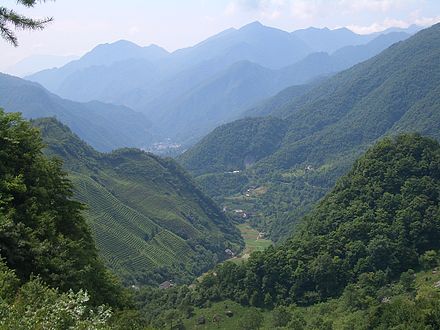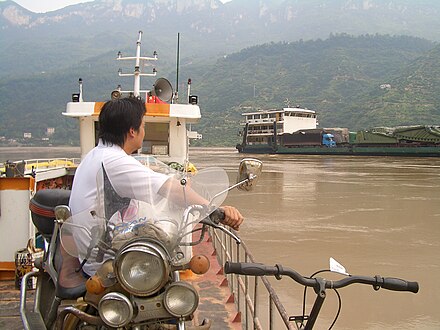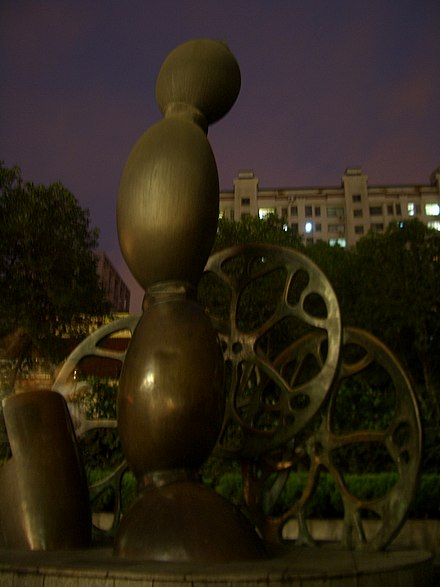Hubei - province of China
Hubei (湖北, Húběi) is a province in the southern central region of China. Its capital and largest city is Wuhan.
Cities
-
Wuhan – the capital, spread across the Han and Yangtze rivers
-
Chibi – city on the banks of the Yangtze river, famous for the Battle of Red Cliffs during the Three Kingdoms period
-
Enshi – the garden of Hubei province
-
Yichang – location of the world's largest dam, the Three Gorges Dam
Other destinations
- Wudang Mountains – birthplace of the tai chi martial art and a UNESCO World Heritage Site
- Site of Tangya Tusi Domain – one of three Tusi sites on the UNESCO World Heritage List
- Hubei Shennongjia – a World Heritage-listed district featuring an eponymous mountain massif with virgin forests
Understand
 Hubei is a Central China province. The name is derived from 'Hu' meaning lake and 'Bei' meaning North. So this is the province north of the Dongting Lake; the province south of the lake is Hunan.
Hubei is a Central China province. The name is derived from 'Hu' meaning lake and 'Bei' meaning North. So this is the province north of the Dongting Lake; the province south of the lake is Hunan.
Much of the eastern Hubei is the densely populated, heavily farmed flatland (the Jianghan Plain) along and between the Yangtze (a.k.a. Changjiang) and the Han River. This is where the province's main metropolic, Wuhan is. The Jianghan Plain is surrounded by low mountain, such as Dabie Shan in the northeast (along the border with Henan and Anhui) and Mufu Shan in the southeast (along the border with Jiangxi).
The west of the province is mountainous, the peaks of Wudangshan and Shennongjia giving you a "preview" of the great mountain systems found in the provinces farther west (Chongqing, Sichuan).
During the Western Zhou, Spring and Autumn, and Warring States periods of the ancient Chinese history, the state of Chu (ca. 1030 BCE–223 BCE) included most of today's Hubei, and the word "Chu" (楚) still appears in the name of the local newspapers, companies, and the like. When China was first unified by the First Emperor, Qin Shi Huang, Chu was absorbed within the Qin, and late Han Empire.
As the Han Empire broke up in the 2nd century CE, the territory of today's Hubei became the area of contact of the Three Kingdoms (San Guo) into which the empire split. Many famous battles of the Three Kingdoms period took place within today's Hubei. Many cities still retain parts of the history of this time, such as Jingzhou which boasts a wonderfully intact city wall dating back to this time.
Located astride the Yangtze River in the very center of the traditional Chinese territory, Hubei was part of the core of both the Ming and Qing Empire. During some centuries it was united with Hunan into a super-province called Huguang. A cadet branch of the Ming Dynasty's ruling Zhu family was ensconced in Wuchang (part of today's Wuhan); three stone turtles (bixi) still stand guard over their tombs at Longquanshan.
In 1911, the Wuchang Uprising in the provincial capital Wuchang (part of today's Wuhan) started the Xinhai Revolution, which soon brought the 250-plus-year-old Qing Empire to the end and ushered the Republic of China.
Since the late 19th century, mineral-rich eastern Hubei became one the centers of China's new mining and metal-working industries. In 1927, the three cities at the confluence of the Yangtze and the Han River - the old provincial capital Wuchang, the industrial Hanyang, and the commercial Hankou, officially merged into the new city of Wuhan, whose name combined syllables from the names of the three old cities. However, it wasn't until several decades later that the first bridge across Yangtze finally established a fixed link between Wuchang and the two other boroughs of the provincial capital.
By the 1930s, communist guerillas started to be active along Hubei's mountainous edges, on the borders with Henan and Anhui. And in the late 1937, as the ROC's capital Nanjing fell to the Japanese invaders, Wuhan became China's temporary capital for a few months. By the fall of 1938, however, after the Battle of Wuhan, the eastern part of the province fell to the Japanese as well, the ROC government being evacuated further upstream to Chongqing. For the following seven years, the front line shifted to the western Hubei.
The lowland of Eastern Hubei had long suffered from the floods of the Yangtze, which often occurred during the late-summer monsoon season. To prevent the floods, and to generate electricity, two major dams were constructed in the west of the province. First, Gezhouba Dam was constructed between 1970 and 1988 in the city Yichang. The giant Three Gorges Dam, the world's largest hydro-electric dam, spanned the river several tens of kilometers further upstream (1994-2003).
Wuchang is known as the educational capital of China boasting a myriad of different Universities and Colleges. Wuchang also has a high concentration of government offices and facilities.
Hankou is famous for its commercial and shopping districts with areas such as Jianghan Rd and Jiefang Rd being the most popular places to go for shopping.
Hanyang is the industrial heart of Wuhan boasting many heavy industries including car and steel manufacture.
Wuhan is one of the notorious '3 furnaces' of China, however it easily out-steams it's rivals Nanjing and Chongqing. During a typical summer temperatures soar above 40 degrees Celsius and humidity rarely drops below 80%. It is because of this weather that the Chinese people believe the local population have gained their fiery reputation of being loud and easily riled up. In winter temperatures drop below 0 degrees Celsius and a few of inches of snow is not uncommon occurrence.
The locals are known as "Jiu Tou Nao" or "nine headed bird" due to their talent for bending the truth. The moniker is both a source of pride and embarrassment.
Wuhan is one of the largest cities in China, however it is still developing, quite slowly, in comparison with the major centres such as Beijing, Shanghai or Shenzhen.
Talk
 The population of Hubei (like all of China) has been taught to speak standard Chinese "Putong Hua" for many years now and the ability to speak Mandarin will help you immensely.
The population of Hubei (like all of China) has been taught to speak standard Chinese "Putong Hua" for many years now and the ability to speak Mandarin will help you immensely.
However, like many places throughout China, many cities have developed their own particular dialect such as the capital city of Hubei's "Wuhan Hua". Many Chinese people do not like the accent of the Wuhan locals as they say it comes across as very unelegant and rude however this is purely a matter of opinion.
Hubei also has members of many minority groups, in particular the Uighers of Xinjiang, who speak a language known as Uigher that is distantly related to Turkish.
Wuhan has strong foreign investment from France and Germany, with corresponding expatriates from these countries living here.
Get in
You can fly into Wuhan Tianhe Airport (IATA: WUH) from most major cities in China and from some international locations. There also smaller airports in a few other cities in central and western Hubei: Yichang (IATA: YIH), Shiyan (IATA: WDS), Xiangyang (IATA: XFN ), Shennongjia, Enshi (IATA: ENH).
You can also catch a bus or a train from many of the cities in China quite easily thanks to Wuhan's central location.
One of the better ways to get into Hubei is to cruise along the Yangtse River, either from Chongqing further West (passing through the Three Gorges Dam and it's massive 5-stage ship lock) or from the East.
Get around
 Getting around in Hubei is fairly easy. Buses go to most cities or at least through them, just let the driver know where to stop. The same goes for getting on the bus, just put out your thumb and a bus will stop for you and tell you how much it costs to go where you want to go.
Getting around in Hubei is fairly easy. Buses go to most cities or at least through them, just let the driver know where to stop. The same goes for getting on the bus, just put out your thumb and a bus will stop for you and tell you how much it costs to go where you want to go.
Hubei also has a decent train network, like the rest of China, however it won't go to quite so many places as the buses and often it is very busy.
Within Wuhan and many other cities in Hubei, bus is the best way to travel. The average fare is ¥1 for non-air conditioned/heated and ¥2 for air-conditioner/heater. Given the number of people on buses and the fact that someone will always have a window open, often it is best just to save the extra ¥1 and go the cheap option.
Taxis are also relatively inexpensive. Flagfall is ¥6 for the first 1.5km
Traveling by bicycle throughout the province is possible, although the road quality and traffic levels vary tremendously. The levees that run along the Yangtze (see the See section, below), if they can be incorporated into your route, can be some of its most pleasant parts.
Few bridges allow bicyclists or pedestrians (those that do include the First and possibly Second Bridges in Wuhan, and the Badong bridge in Badong); ferries, still available at many locations, are a practical alternative.
See
The Yangtze River crosses through the region, offering beautiful cruise options, but the scenery past Wuhan is not as great as in the neighbouring provinces of Sichuan and Chongqing
The main tourist attractions and sights in Hubei are located along the Yangtse River.
You can see the famous Ghost City of Feng Du with its temples and statues, the Three Gorges Dam and its 5-Stage Ship Lock in Yichang, the impressive city wall of Jingzhou, and the famous Yellow Crane Tower "Huang He Lou" and East Lake "Dong Hu" of Wuhan.
The Yangtze levees (长江提防).
In the lowlands of eastern and central Hubei (the Jianghan Plain), the Yangtze is lined with levees (embankments), protecting fields and villages from floods. The top of the levees is well paved, making them pleasant paths for walking, running, and biking. Typically, there is only a very limited amount of motor vehicle traffic on the levee roads - farmers accessing their fields, people who have come to fish or to fly a kite, and occasional tourists. The levee path can be accessed at many locations via paved farm roads, or via roads that run to river docks.
The Yangtze levees mostly run through agricultural terrain. A major afforestation program has been underway for some years, narrow strips of forest being planted on both sides of each levee. In the areas where the trees have grown tall, these rows of trees among the fields allow one to identify the location of the levee from a kilometer or two away.
Kilometer markers are placed along the length of the levees; the distance, on each side of the river, is measured in the upstream direction (i.e. from the Anhui border on the north side of the river, and from the Jiangxi border on the south side).
Even though the levees, in principle, are continuous (as required by their flood-protection purpose), they, unfortunately, don't form a continuous path through the entire province, or even through any single county. Numerous breaks exist at construction sites, harbor facilities, and at the points where major tributaries enter the Yangtze. (At such points, the levee continues inland along the tributary, but the closest bridge across that tributary may not be all that close, or it may not be accessible from the levee). Perusing satellite images on Google Maps (alas, not accessible from within China itself without a VPN) may be the best way to identify continuous sections of the levees and the access points. Free
Do
Eat
 Being in the center of China, Hubei boasts a variety of gourmet delights from every corner of the Chinese nation. Whether it is the delicious kebabs or hand-pulled noodles "la mian" of Xinjiang in the West, the addictive pork and spring onion dumplings "jiao zi" of the North, the farmed sweet and sour "tang su" of the South or the myriad of seafood dishes of the East there is something to please everyone.
Being in the center of China, Hubei boasts a variety of gourmet delights from every corner of the Chinese nation. Whether it is the delicious kebabs or hand-pulled noodles "la mian" of Xinjiang in the West, the addictive pork and spring onion dumplings "jiao zi" of the North, the farmed sweet and sour "tang su" of the South or the myriad of seafood dishes of the East there is something to please everyone.
Like most food to be found in Central/Western China, the food of Hubei is liberally laden with chilli, exciting the taste buds of more adventurous gourmands. All of the famous Chinese exotic foods can be found in Hubei, ranging from dog and cat, to snail and frog, to pig's blood and cow's stomach all the way through to BBQ scorpion kebabs.
Hubei is also famed for it's lotus root "ou" dishes, which you can get in a variety of forms from soups to french fried. The capital city, Wuhan, also has a famous noodle dish by the name of Hot and Dry Noodles "re gan mian". This interesting dish combines the dryness of sesame paste with the heat of chillis and pickled vegetables. Generally a breakfast staple, hot and dry noodles can be found being cooked on every street of Wuhan and for around ¥1.70 it is an absolute bargain.
As has been the growing trend in China there has also been a growth in 'Western' style restaurants. You can go and eat at a Brazil BBQ restaurant, Italian, Portuguese and French restaurants, as well as the omnipresent American fast food outlets such as Pizza Hut, KFC and McDonalds.
Drink
Hubei generally consumes the same style of beverages as the rest of China. Tea and hot water being the most popular, followed by soft drinks, beer and "bai jiu".
One of the highlights of Hubei is the local beer, going by the name of 'Snow' which generally comes in 500mL bottles and can be chilled. The going rate for a bottle is ¥2.50 with a ¥0.5 refund when you return the bottle.
The most abundant by far are the famous Chinese 'discos' and 'KTV' bars which charge drinks at a minimum of a 500% markup and often times exceed 1000%. There are a small number of 'foreign bars', generally also expensive but with an environment which is catered more to foreign tastes.
In Wuhan itself there is the local institution 'Vox Bar' which is easily the cheapest and most diverse bar in the province, with beer starting from ¥5 and hosting a variety of different live bands ranging from Beijing heavy metal to Xinjiang folk music. The patrons of Vox come from every corner of the world as well as of course the local Chinese.
